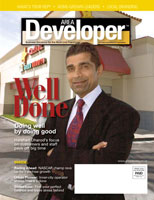Tech Talk
Site selection on steroids
Computer technology seems to follow a fairly regular path: first, it automates operations, gaining some time and savings for large operations. Then it becomes cheaper, widespread, and more capable of handling routine tasks. Then it begins to change business functions themselves by enabling tasks that could never be performed before.
Site selection is becoming a case in point. Mapping software has generally progressed to the point that computers can offer good demographic maps to help guide franchisees to the best locations for their stores. But it has still been up to the franchisee and broker, with some guidance from the franchisor, to find and settle on locations.
Now comes geoVue, a company that is taking site software to that new level.
“The retail industry is finally starting to make fact-based decisions, and we can deliver the analytics,†says geoVue CEO Rudy Nadilo. “This industry has gone from being maps and charts to talking with clients about how we can help them optimize their capital plan.â€
Nadilo came to the company from a background in information services, where he was in the middle of the move to using bar codes in a way that revolutionized the way supermarket chains conducted their business. Now, he says, franchise companies are learning what the supermarkets did: that to improve margins, you need to “optimize the network.â€
This means that discussions between geoVue and clients occur at a different level than standard site-mapping operations. The geoVue software is able to map not only populations and preferences, but what makes a particular location successful. It can predict how many stores are optimal for a given area. And then, says Nadilo , the software can say what stores may need to be closed or redone.
The idea, he says, is to make sure you don’t have too many or too few stores in a territory, and that they are in the right places for the customers you want to reach. Although that might sound like traditional site mapping, it’s not. To the demographic data, the geoVue product adds information from its own customer data in a number of industries to evaluate potential markets, sales potential, and the impact of competitors and other stores on projected growth.
The company has been working with several franchises, including Papa Murphy’s, Dunkin’ Donuts, and Cereality, a new franchise concept just beginning to grow through area developers. Cereality offers a mix of cereals at any time of day. Built on the idea of “Saturday morning any time,†the franchise has special “bowls,†and a large number of toppings that cater to a surprisingly popular cereal fixation.
Odd as the idea might sound, the company has been flooded with inquiries about franchises. Cereality has only three stores open and another opening in Indianapolis, but has had 8,000 inquiries and 2,500 serious applicants. It has signed some deals with area developers and is discussing more.
Stan Synkoski, COO of Cereality, says that geoVue was right for their expansion strategy. “We looked a number of different companies, trying to understand the entire country on a block level. There are more than 300,000 block groups in the U.S., and we looked at the demographic and psychographic profiles of each.†Working with geoVue, the company ranked them, to see how likely they were to be a Cereality customer. “Now when we talk to someone we can tell them approximately how many locations a county will support and where they should be located,†he says.
The process “gets us through the development agreement,†says Synkoski, who was an executive with the company that brought franchises into airports. Area developers with Cereality will know how many units a territory will support �"and where they should be.
The franchisee can then log into the geoVue portal and see what the order of building should be. Basically, says Nadilo, the franchisee can be sitting with a broker talking about five sites. From a laptop, he can log into the system and ask for the sites to be ranked. The geoVue system then ranks them, or says that one or another should not be considered at all. “That’s better than submitting them to a real estate department and waiting a week for an answer,†he says.
It’s a strategy of “optimum saturation,†says Synkoski. “The stores can combine with our mobile units and kiosks. As we’re getting ready to build out a territory the mobile unit brings awareness into the area.†He says the company turned to geoVue early on “to make sure both we and our franchise partners are successful. We’re giving them a jump start on their area development.â€
The analytical data that geoVue provides, he says, means that units will operate in ways you don’t expect. For example, everyone’s natural assumption is that this is a breakfast concept. Not so, he says. “The one in Philadelphia does gangbusters lunch and late afternoon business. The geoVue thing makes sense because it tells you that people will be customers when they’re out for other things.â€
Says Nadilo, it’s all about “how to localize marketing and merchandising.†And used correctly, he says, it also will tell executives about the status of current stores.
The difference with geoVue, says Nadilo is this: “If a client comes in with 300 stores and plans to add 20 or 50, they want to know where to put them. We ask what their 300 stores are about, and see if they match what the company is trying to do. We call that ‘optimizing the network.’ Some of the stores might be in bad spots, or the market has changed, or the business has good characteristics but a store is doing badly. You have to matrix out your existing stores and optimize them.â€
The goal, he says, is to get the right number of stores in a given territory�"not too many because you cannibalize existing stores, and not too few because you’ll be giving up revenue. In either case, the P&L suffers. Optimizing the market requires some science.
“The system takes into account existing stores and competition,†he says. “So it’s a new way of doing things. And our clients make the decision that ‘The next store I add we will apply this discipline.’†Franchisors using the software, such as Cereality, Dunkin’ Donuts, and others, have changed their contracts to require franchisees to put their site selection through the geoVue system.
Nadilo believes that the system can “alleviate a lot of pain. What I think geoVue does in a nutshell is to stop talking about tools and software and really talk about being a partner to help your business�"not just running a map and choosing a location. I’ve talked with a number of financial guys in two meetings in the last month who had no idea that these tools were available. They look at the cost of this, and say ‘If you avoid one or two bad stores it pays for itself.’â€
Wirecutting made easy
Wires are a pain, and simply not practical for a lot of today’s mobile workforce. But getting new PDAs for everyone is expensive and can be a nightmare to support.
Coverall, the cleaning franchise, turned to mFoundry’s solution: a server platform that allows anyone with moderate computer skills to create applications that run on any cell phone.
“Any average enterprise IT guy who wants to mobilize part of his business doesn’t have to have advanced program skills,†says Drew Seviers, co-founder and CEO of mFoundry.
In the case of Coverall, field reps would take a clipboard, mark up a sheet for a proposal, go back to the office and fax it, and then five people would key it in. “In a week or so that information would be available. By then, they’d lost the customer, or the customer was annoyed,†says Seviers. “They created an application using our technology. Now, the field rep walks into an area, opens the phone, inputs the location and condition, presses ‘Submit,’ and goes back through our servers directly into the Coverall data center, which then has real-time access. They’ve saved half a million dollars this year, so they are happy.â€
As far as equipment is concerned, smaller companies are happy that they don’t have to buy new phones. And all of it is much cheaper and faster than hiring a consultant who will write an application that runs only on a unit that costs a thousand dollars.
Seviers says that mFoundry is going after small and mid-sized businesses. “It’s a no-brainer for franchise companies,†he says. “Any time someone is using paper that needs to be input, this is a very easy sale.â€
The model is the application service provider (ASP), in which the customer pays a monthly fee to use the servers�"which are, he says, very fast, because you only connect to the Internet when you’re sending and receiving. You don’t need to be connected all the time.
“It’s a low cost of entry and ownership,†Seviers says.
Share this Feature
Recommended Reading:
Comments:
comments powered by DisqusFRANCHISE TOPICS
- Multi-Unit Franchising
- Get Started in Franchising
- Growth
- Operations
- Open New Units
- Leadership
- Marketing
- Technology
- Legal
- Awards
- Rankings
- Trends
- Featured Franchise Stories
FEATURED IN

Multi-Unit Franchisee Magazine: Issue 4, 2006
$200,000
$250,000




 The multi-unit franchise opportunities listed above are not related to or endorsed by Multi-Unit Franchisee or Franchise Update Media Group. We are not engaged in, supporting, or endorsing any specific franchise, business opportunity, company or individual. No statement in this site is to be construed as a recommendation. We encourage prospective franchise buyers to perform extensive due diligence when considering a franchise opportunity.
The multi-unit franchise opportunities listed above are not related to or endorsed by Multi-Unit Franchisee or Franchise Update Media Group. We are not engaged in, supporting, or endorsing any specific franchise, business opportunity, company or individual. No statement in this site is to be construed as a recommendation. We encourage prospective franchise buyers to perform extensive due diligence when considering a franchise opportunity.